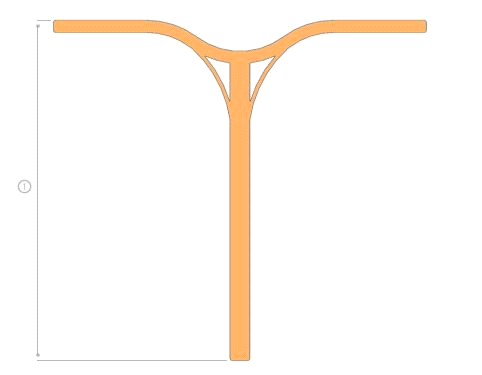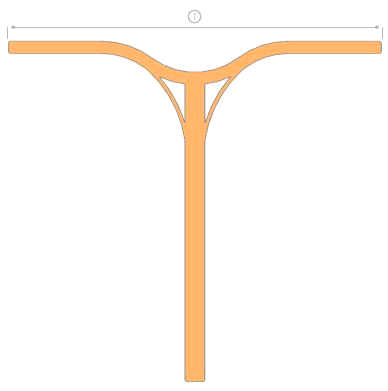Stunt Scooter Bars
Bars are the second most important part of a scooter. After the very first steel handlebars from RAD Skoot Co. came out in 2006, followed by the first SR "Buff" (now "Proto") aluminium handlebars and the 2007 FrenchID Pro handlebars, the retractable and folding handlebars for scooters were clearly outmoded and replaced by the one-piece handlebars.
Material
Two metals are used in the production of handlebars: steel and aluminium. Aluminium bars are very light (between 700 and 900 g), which is suitable both for young riders and for people who want to turn "light" handlebars. However, it is very clear that aluminium is stiffer than steel, which means that it can break more quickly and that the comfort of steel handlebars is much higher. Most steel handlebars (4130 chromoly) are very heavy, mostly between 1,000 and 1,500 g, but they are also much more comfortable and less rigid, allowing for a higher load.
Weight
The weight of a handlebar, unlike other scooter parts, is not decisive, as it is well placed on the scooter and, with the exception of the Crosstube, hardly moves. Switching from aluminium to steel handlebars usually makes a difference when you switch from plastic to foam grips (see Handles). As the bar is at the front of the scooter, the use of steel handlebars can be beneficial to achieve better balance (see below). However, if you want a very light scooter, an aluminium bar is also a good choice.
Height
The height of a handlebar is measured from the lower end to the highest point.
Of course, the ideal height depends on your own size and personal needs. To determine this "perfect" height for you, there is a trick: get on your scooter so that your back is straight. The height you reach with your hands, when your arms are straight, should be the optimal height for you.
Smaller handlebars are generally intended for an aggressive riding style, larger handlebars are more comfortable, but give you a straighter style. The higher the handlebars are, the further your hands will be from the deck, which means it will be easier to do a TailWhip, but BarSpins and Fingerwhips will certainly be better with lower handlebars.
Basically, there is no real rule, as there are pro riders who use short handlebars and vice versa, and beginner riders with high handlebars, so you have to do your best to find what suits you best.
Width
The width of the handlebars has changed a lot over the years: in 2007, the standard width was still 330mm; nowadays, it is not uncommon to ride handlebars with a maximum width of 700mm. Narrow handlebars can make handling easier if you're used to them, but many other things can get in the way and you tend to be less comfortable. The wider the handlebars, the more comfortable you will be, but this will make certain movements such as handlebar rotation more difficult as the leverage is stronger with wide handlebars.
You should first consult the different brands for information on these bars to avoid the risk of handlebar breakage when performing tricks.
Backsweep (it is the angle of the rear grips in relation to the vertical axis of the handlebars.)
Backsweep handlebars were introduced for scooters in 2008 with RAD Vulture handlebars. Backsweep means that the Crosstube makes a slight bend on both sides, which some people find more comfortable on the wrists. It depends on your personal taste, whether you want a handlebar with or without back sweep.
Upsweep (it is the angle of the grips forward in relation to the vertical axis of the handlebars)
Just like the backsweep, there are handlebars that have a slight bend up or down the Crosstube. Everyone has to decide what they like or don't like.
Slot
Most handlebars have a small slot (clamp slot) allowing the clamp to tighten the bar on the fork. Slotless handlebars are manufactured exclusively for the SCS compression system. If you still want to use them with another compression system (ICS or other), simply saw a 5 cm slot with a hacksaw or flexible cable, provided that the inner and outer diameter of the handlebars match the requirements of your compression system. (See Compression Systems).
Butted (Thickness variation)
Butted is a technology that has been adopted on the BMX scene. It allows for handlebars with different wall thicknesses to be produced at different locations. This is usually used where the grips are located to save weight. However, as this technology is very expensive, you will only find it in high-end bars.
Handlebar diameter 31.8 / 34.9
Previously, all freestyle scooter handlebars had an outer diameter of 31.8 mm, but with the introduction of ALU handlebars and the HIC compression system, 34.9 mm handlebars were added. So always remember which compression system and clamp type are compatible before buying new handlebars.
Which handlebar or handlebar brand to choose according to the type of ride street or park?
For a Street Ride, we prefer HIGH handlebars such as: TILT bars, and LONGWAY bars.
For a ParkRide, we prefer LOWER handlebars such as: Reaper V2 bars, and Fasen bars.



















